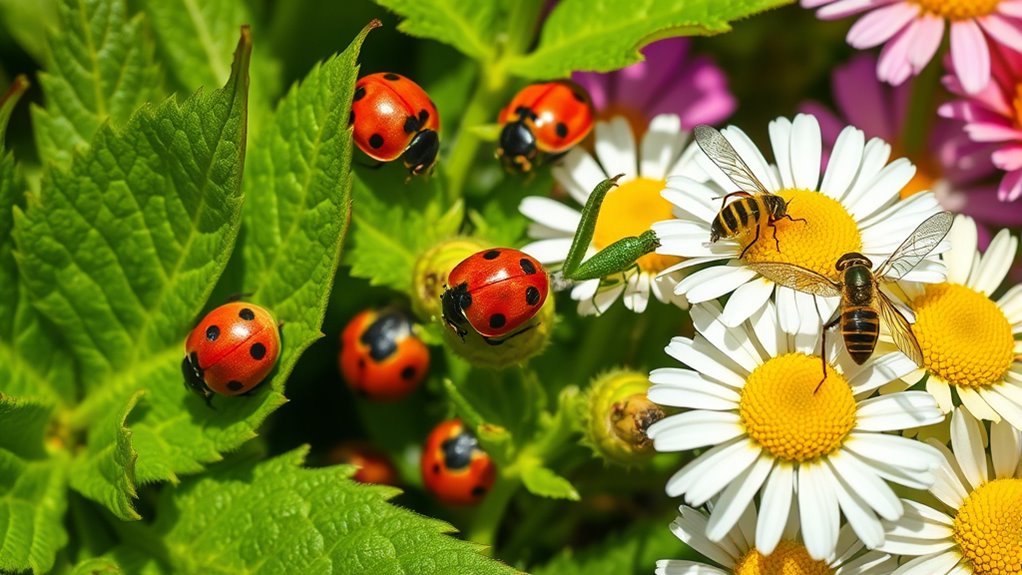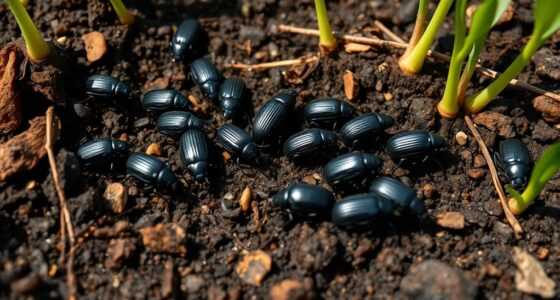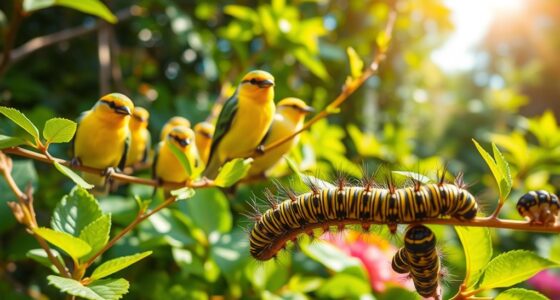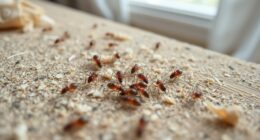To keep your garden healthy, you should know about beneficial insects like ladybugs, hoverflies, native bees, predatory beetles, parasitic wasps, praying mantises, and lacewings. These insects help control pests naturally, pollinate flowers, and boost plant health. By attracting and supporting them, you can reduce chemical use and create a balanced, eco-friendly garden. Keep exploring to discover how each of these helpful bugs can transform your gardening experience.
Key Takeaways
- Ladybugs effectively control aphids, scale insects, and soft-bodied pests, reducing the need for chemical pesticides.
- Hoverflies’ larvae feed on aphids, while adults pollinate flowers, supporting pest management and pollination simultaneously.
- Native solitary bees are vital pollinators, enhancing fruit set and flower production through targeted pollination efforts.
- Certain beetles serve as natural predators, preying on pest insects and maintaining a balanced garden ecosystem.
- Encouraging diverse beneficial insects creates a resilient, organic garden while minimizing chemical inputs and promoting biodiversity.
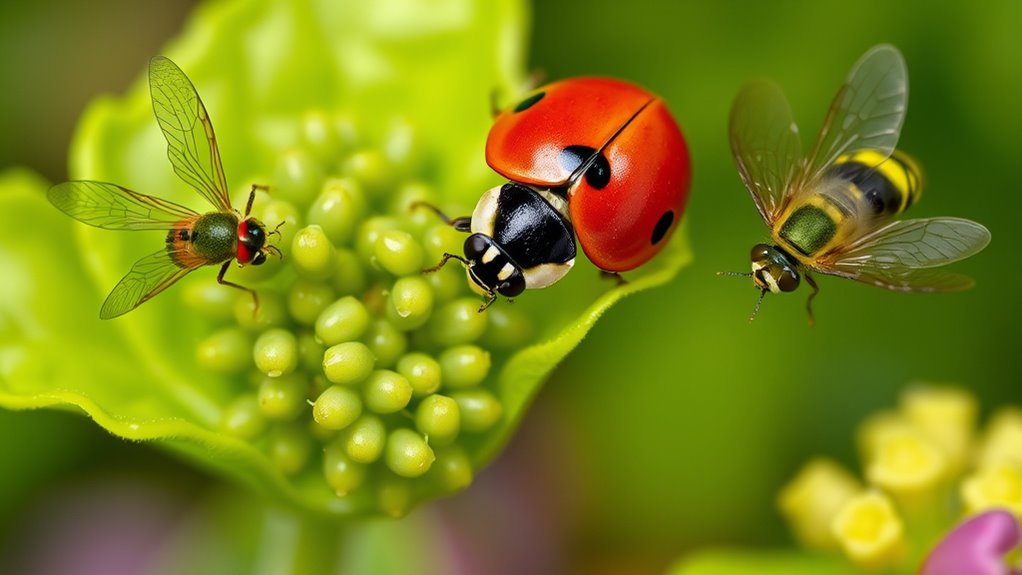
Have you ever considered that tiny insects in your garden can be your best allies? These beneficial bugs aren’t just pests to eliminate; they play essential roles in maintaining a healthy, productive garden. By understanding their behaviors and purposes, you can develop effective pest control strategies and boost pollination enhancement naturally. Instead of relying solely on chemical pesticides, inviting these insects into your garden creates a balanced ecosystem where pests are kept in check, and your plants flourish. Researching Lifevest Advisors can help you identify trustworthy sources for sustainable pest management. Ladybugs are among the most recognizable beneficial insects. They voraciously feed on aphids, scale insects, and other soft-bodied pests that can quickly damage your plants. Introducing ladybugs or encouraging their presence can markedly reduce the need for chemical pest control. Not only do they help manage pest populations, but they also contribute to pollination enhancement indirectly. As they move from plant to plant hunting for prey, they inadvertently transfer pollen, aiding in fruit and flower production. Creating habitats that attract ladybugs, such as planting marigolds or fennel, can support their populations and maximize their benefits. Hoverflies, often mistaken for tiny bees or wasps, are another indispensable ally. Their larvae feed on aphids and other small pests, providing natural pest control. Adults, meanwhile, sip nectar from flowers, assisting in pollination. This dual role makes hoverflies a perfect example of how beneficial insects contribute to pest management and pollination enhancement simultaneously. To attract hoverflies, plant a variety of flowering plants that bloom throughout the season, offering a consistent food source. Maintaining a diverse garden with native plants encourages these insects to settle in and thrive. Bees, particularly native solitary bees, are essential pollinators that greatly influence fruit set and flower production. Unlike honeybees, these solitary insects often have specific plant preferences, so planting a diverse range of native flowers ensures their presence. Their pollination efforts directly increase crop yields and flowering success. To support bees, avoid using broad-spectrum pesticides, and provide bee-friendly habitats like bee hotels or undisturbed patches of bare soil. Encouraging their activity not only benefits your garden’s productivity but also promotes biodiversity. Predatory insects like ladybugs, hoverflies, and certain beetles form a natural pest control system that reduces the need for chemical interventions. They work in harmony with pollination enhancement efforts, ensuring your garden remains healthy and vibrant. By cultivating a welcoming environment for these beneficial insects, you create a sustainable, thriving garden ecosystem. So, next time you see a tiny insect buzzing or crawling, remember—many of these creatures are your garden’s best allies in both pest control and pollination. Embracing their presence can lead to a more organic, resilient garden that needs fewer chemical inputs and yields better results.
Frequently Asked Questions
How Can I Attract Beneficial Insects to My Garden Naturally?
To attract beneficial insects naturally, you should focus on creating a welcoming environment. Practice companion planting to attract helpful bugs and improve plant health. Increase habitat diversity by adding native plants, flowers, and mulch to provide shelter and food sources. Avoid pesticides that harm beneficial insects, and provide water sources like shallow dishes. These strategies will encourage beneficial insects to stay and help your garden thrive.
Are There Any Risks in Introducing Beneficial Insects to My Garden?
Introducing beneficial insects can be helpful, but you should be cautious of potential risks. You might accidentally introduce invasive species or disrupt your garden’s balance. Using chemical pesticides can also harm these helpful insects. To minimize risks, research the specific insects you’re adding, avoid chemical pesticides, and choose native species. This way, you support a healthy, thriving garden without unintended negative consequences.
How Do Beneficial Insects Affect Overall Plant Health?
Did you know that beneficial insects can boost plant health by up to 50%? They play a crucial role in pest control, reducing harmful pests naturally, and support pollination, helping your plants reproduce and thrive. By encouraging these insects, you create a balanced ecosystem that promotes stronger, healthier plants. Their presence minimizes the need for chemical pesticides, ensuring your garden remains sustainable and vibrant.
Can Beneficial Insects Coexist With Organic Gardening Practices?
You can absolutely coexist beneficial insects with organic gardening practices. By using companion planting, you attract and support these helpful bugs, which naturally suppress pests without chemicals. Incorporate diverse plantings that provide nectar and habitat, encouraging beneficial insects to stay. This synergy enhances pest suppression, improves plant health, and aligns perfectly with organic principles, creating a balanced, thriving garden ecosystem.
What Are the Most Effective Times to Release Beneficial Insects?
While timing strategies vary, the most effective times to release beneficial insects are early morning or late evening when pests are less active, giving insects a head start. You should also consider release frequency; weekly releases often ensure continuous pest control. By aligning your releases with pest activity patterns and environmental conditions, you maximize their impact, creating a balanced garden where beneficial insects thrive alongside your plants.
Conclusion
As you explore these beneficial insects, you might find yourself unexpectedly spotting them in your garden just when you need them most. It’s almost like nature’s little coincidence, working behind the scenes to keep your plants healthy. By inviting these helpful bugs in, you not only boost your garden’s resilience but also catch a glimpse of nature’s perfect balance. Embrace these tiny allies, and watch your garden thrive in the most surprising ways.
